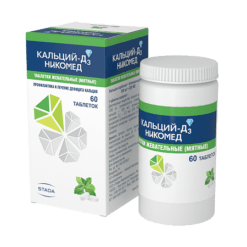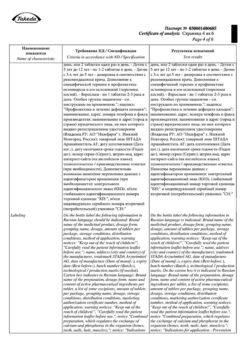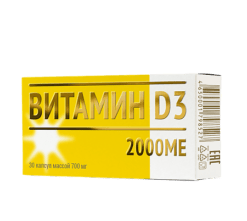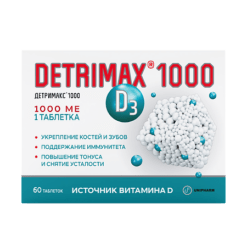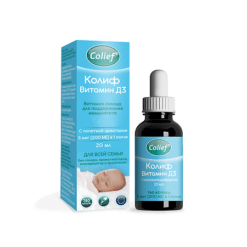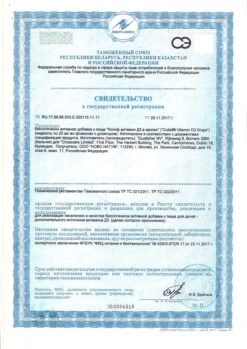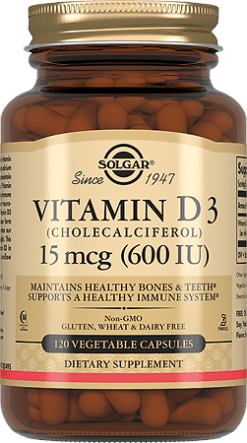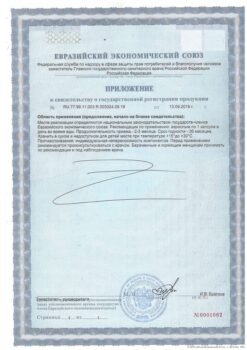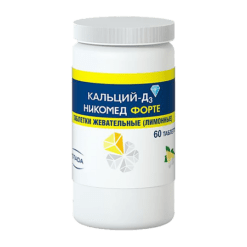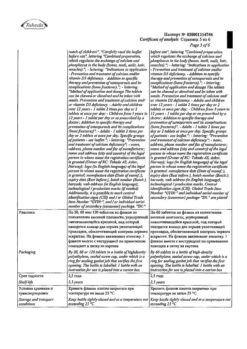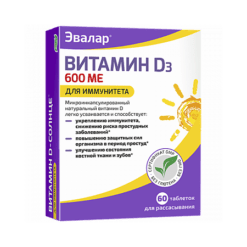No products in the cart.
Fortedetrim, Capsules 10000 me 30 pcs
€42.15 €35.12
Description
Calcium-phosphorus metabolism regulator.
Pharmacokinetics
Intake
Calciferol (vitamin D3) when taken orally is almost completely absorbed (80%) in the small intestine. Maximum concentration in tissues is reached after 4-5 hours, after which the concentration decreases slightly, remaining constant for a long time. After a single oral administration of colecalciferol the maximum concentration in serum of the basic form is reached after about 7 days.
Distribution
Calciferol accumulates in the liver, bones, skeletal muscles, kidneys, adrenal glands, myocardium, adipose tissue. Maximum concentration in the tissue is reached after 4-5 hours, after which the concentration decreases slightly, remaining constant for a long time.
It is subjected to intestinal-hepatic recirculation. Serum concentrations of the inactive metabolite 25-hydroxycalciferol (25(OH)D3, calcidiol) may be increased for several months after high doses of colocalciferol. Hypercalcemia caused by overdose may persist for several weeks.
Metabolism
Calciferol binds to plasma alpha-2-globulins and partially to albumin and is transported to the liver, where microsomal hydroxylation occurs to form the inactive metabolite 25-hydroxycalciferol (25(OH)D3, calcidiol).
The concentration of calcidiol circulating in the blood is an indicator of vitamin D levels in the body. Calcidiol undergoes re-hydroxylation in the kidneys to form the dominant active metabolite 1,25 hydroxycalciferol (1,25(OH)2D3, calcitriol).
Elimination
25(OH)D3 is slowly excreted with a half-life of about 50 days. The main way of excretion of colecalciferol, as well as its metabolites is bile (feces), and at least 2% of these substances are excreted by the kidneys. Colecalciferol penetrates the placental barrier and passes into breast milk.
Pharmacodynamics
Vitamin D3 is the natural form of vitamin D, which is formed in humans in the skin by the action of sunlight. Compared with vitamin D2, it is characterized by 25% higher activity.
Vitamin D binds to a specific vitamin D receptor (VDR) that regulates the expression of many genes, including the TRPV6 ion channel genes (provides calcium absorption in the intestine), CALB1 (calbindin; provides calcium transport into the bloodstream), BGLAP (osteocalcin; provides bone mineralization and calcium homeostasis), SPP1 (osteopontin; regulates osteoclast migration), REN (renin; provides blood pressure regulation, being a key element of renin-angiotensin-aldosterone regulation system), IGFBP (insulin-like growth factor binding protein; enhances the action of insulin-like growth factor), FGF23 and FGFR23 (fibroblast growth factor 23; regulates calcium levels, phosphate anion, fibroblast cell division processes), TGFB1 (transforming growth factor beta-1; regulates cell division and differentiation processes of osteocytes, chondrocytes, fibroblasts and keratinocytes), LRP2 (LDL-receptor-related protein 2; mediates endocytosis of low-density lipoproteins), INSR (insulin receptor; provides insulin effects on all cell types).
Vitamin D3 is an active anti-rachitis factor. The most important function of vitamin D3 is to regulate calcium and phosphate metabolism, which promotes proper mineralization and skeletal growth.
Calciferol plays an essential role in the absorption of calcium and phosphate in the intestine, in the transport of mineral salts and in the calcification of bones, and also regulates the excretion of calcium and phosphate by the kidneys.
The concentration of calcium ions in blood determines the muscle tone of skeletal muscles, myocardial function, contributes to nerve stimulation and regulates the process of blood clotting.
Deficiency of vitamin D in food, disorders of its absorption, calcium deficiency, as well as lack of exposure to the sun during rapid growth of children leads to rickets, osteomalacia in adults, pregnant women may show symptoms of tetany, disruption of bone calcification in newborns.
The increased need for vitamin D occurs in women during menopause, as they often develop osteoporosis due to hormonal disorders. Vitamin D has a number of so called extracellular effects.
Vitamin D is involved in the functioning of the immune system by modulating cytokine levels and regulates the division of T-helper lymphocytes and the differentiation of B-lymphocytes. A number of studies have shown a decrease in the incidence of respiratory tract infections with vitamin D supplementation.
It is shown that vitamin D is an important link in homeostasis of the immune system: it prevents autoimmune diseases (diabetes mellitus type 1, multiple sclerosis, rheumatoid arthritis, inflammatory bowel diseases, etc.).
Vitamin D has antiproliferative and pro-differentiation effects, which determine the oncoprotective effect of vitamin D. It is noted that the incidence of some tumors (breast cancer, colon cancer) is increased with low levels of vitamin D in the blood.
Vitamin D is involved in the regulation of carbohydrate and fat metabolism by affecting the synthesis of IRS1 (insulin receptor substrate 1; involved in intracellular pathways of insulin receptor signaling), IGF (insulin-like growth factor; regulates the balance of adipose and muscle tissue), PPAR-δ (activated peroxisome proliferator-activated receptor type δ; promotes recycling of excess cholesterol).
According to epidemiological studies, vitamin D deficiency is associated with the risk of metabolic disorders (metabolic syndrome and type 2 diabetes). Vitamin D receptors and metabolizing enzymes are expressed in arterial vessels, the heart and virtually all cells and tissues relevant to the pathogenesis of cardiovascular disease.
In animal models antiatherosclerotic effects, suppression of renin and prevention of myocardial damage, etc., have been shown. Low levels of vitamin D in humans are associated with adverse cardiovascular risk factors such as diabetes, dyslipidemia, arterial hypertension, and are associated with the risk of cardiovascular accidents, including strokes.
In studies in experimental models of Alzheimer’s disease, vitamin D3 has been shown to reduce amyloid accumulation in the brain and improve cognitive function.
In non-interventional studies in humans, the incidence of dementia and Alzheimer’s disease has been shown to increase with low vitamin D levels and low dietary intake of vitamin D. There has been a worsening of cognitive function and the incidence of Alzheimer’s disease at low levels of vitamin D.
Additional information
| Manufacturer | Medana Pharma, Poland |
|---|---|
| Medication form | capsules |
| Brand | Medana Pharma |
Other forms…
Related products
Buy Fortedetrim, Capsules 10000 me 30 pcs with delivery to USA, UK, Europe and over 120 other countries.



